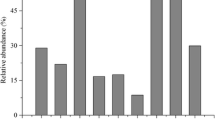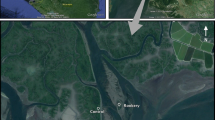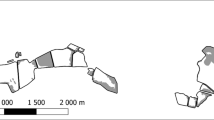Abstract
The coastal wetlands of northeastern Florida Bay are seasonally-inundated dwarf mangrove habitat and serve as a primary foraging ground for wading birds nesting in Florida Bay. A common paradigm in pulse-inundated wetlands is that prey base fishes increase in abundance while the wetland is flooded and then become highly concentrated in deeper water refuges as water levels recede, becoming highly available to wading birds whose nesting success depends on these concentrations. Although widely accepted, the relationship between water levels, prey availability and nesting success has rarely been quantified. I examine this paradigm using Roseate Spoonbills that nest on the islands in northeastern Florida Bay and forage on the mainland. Spoonbill nesting success and water levels on their foraging grounds have been monitored since 1987 and prey base fishes have been systematically sampled at as many as 10 known spoonbill foraging sites since 1990. Results demonstrated that the relationship between water level and prey abundance was not linear but rather there is likely a threshold, or series of thresholds, in water level that result in concentrated prey. Furthermore, the study indicates that spoonbills require water level-induced prey concentrations in order to have enough food available to successfully raise young.







Similar content being viewed by others
References
Allen RP (1942) The roseate spoonbill. Dover Publications Inc., New York
Bancroft GT, Strong AM, Sawicki RJ, Hoffman W, Jewell SD (1994) Relationships among wading bird foraging patterns, colony locations, and hydrology in the Everglades. In: Davis SM, Ogden JC (eds) Everglades: the ecosystem and its restoration. St. Lucie Press, Delray Beach, pp 615–658
Bjork RD, Powell GVN (1994) Relationships between hydrologic conditions and quality and quantity of foraging habitat for Roseate Spoonbills and other wading birds in the C-111 basin. Final report to the South Florida Research Center, Everglades National Park, Homestead, Florida
Browder JA, Gleason PJ, Swift DR (1994) Periphyton in the Everglades: spatial variation, environmental correlates and ecological implications. In: Davis SM, Ogden JC (eds) Everglades: the ecosystem and its restoration. St. Lucie Press, Delray Beach, pp 379–418
De la Court C, Aguilera E (1997) Dispersal and migration in Eurasian spoonbills. Ardea 85:193–202
DeAngelis DL, Loftus WF, Texler JC, Ulanowicz RE (1997) Modeling fish dynamics and effects of stress in a hydrologically pulsed ecosystem. J Aquat Ecosyst Stress Recover 6:1–13
Duever MJ, Meeder JF, Meeder LC, McCollom JM (1994) The climate of south Florida and its role in shaping the Everglades ecosystem. In: Davis SM, Ogden JC (eds) Everglades: the ecosystem and its restoration. St. Lucie Press, Delray Beach, pp 225–248
Dumas J (2000) Roseate Spoonbill (Ajaia ajaja). In: Poole A, Gill F (eds) The birds of North America, No. 490. The Birds of North America, Inc, Philadelphia
Frederick PC, Collopy MW (1989) Nesting success of five ciconiiform species in relation to water conditions in the Florida Everglades. Auk 106:625–634
Frederick PC, Loftus WF (1993) Responses of marsh fishes and breeding wading birds to low temperatures: a possible behavioral link between predator and prey. Estuaries 16:198–215
Frederick PC, Spalding MG (1994) Factors affecting reproductive success in wading birds. In: Davis SM, Ogden JC (eds) Everglades: the ecosystem and its restoration. St. Lucie Press, Delray Beach, pp 659–692
Gawlik DE (2002) The effects of prey availability on the numerical response of wading birds. Ecol Monogr 72:329–346
Herring G, Cook MI, Gawlik DE, Call EM (2011) Food availability is expressed through physiological stress indicators in nestling white ibis: a food supplementation experiment. Funct Ecol 25:682–690
Higer AL, Kolipinski MC (1967) Pull-up trap: a quantitative device for sampling shallow water animals. Ecology 48:1008–1009
Hoffman W, Bancroft GT, Sawicki RJ (1994) Foraging habitat of wading birds in the water conservation areas of the Everglades. In: Davis SM, Ogden JC (eds) Everglades: the ecosystem and its restoration. St. Lucie Press, Delray Beach, pp 585–614
Holmquist JG, Powell GVN, Sogard SM (1989) Sediment, water level and water temperature characteristics of Florida Bay’s grass-covered mud banks. Bull Mar Sci 44:348–364
Kahl MP (1964) Food ecology of the wood stork (Mycteria american) in Florida. Ecol Monogr 34:97–117
Kushlan JA (1976a) Environmental stability and fish community diversity. Ecology 57:821–825
Kushlan JA (1976b) Wading bird predation in a seasonally fluctuating pond. Auk 93:464–476
Kushlan JA (1978) Feeding ecology of wading birds. In: Sprunt A, Ogden JC, Winckler S (eds) Wading birds: research report no. 7 of the National Audubon Society. National Audubon Society, New York, pp 249–299
Kushlan JA (1980) Population fluctuations in Everglades fishes. Copeia 1980:870–874
Loftus WF, Eklund AM (1994) Long-term dynamics off an Everglades small-fish assemblage. In: Davis SM, Ogden JC (eds) Everglades: the ecosystem and its restoration. St. Lucie Press, Delray Beach, pp 461–483
Loftus WF, Kushlan JA (1987) Freshwater fishes of southern Florida. Bull Florida State Mus Biol Sci 31:137–344
Lorenz JJ (1999) The response of fishes to physicochemical changes in the mangroves of northeast Florida Bay. Estuaries 22:500–517
Lorenz JJ (2000) Impacts of water management on roseate spoonbills and their piscine prey in the coastal wetlands of Florida Bay. Dissertation, University of Miami
Lorenz JJ, Dyer K (2010) Roseate spoonbill nesting in Florida Bay annual report 2009–10. South Florida Wading Bird Rep 16:13–16
Lorenz JJ, Serafy JE (2006) Changes in the demersal fish community in response to altered salinity patterns in an estuarine coastal wetland: implications for Everglades and Florida Bay restoration efforts. Hydrobiologia 569:401–422
Lorenz JJ, McIvor CC, Powell GVN, Frederich PC (1997) A drop net and removable walkway for sampling fishes over wetland surfaces. Wetlands 17:346–359
Lorenz JJ, Ogden JC, Bjork RD, Powell GVN (2002) Nesting patterns of roseate spoonbills in Florida Bay 1935–1999: implications of landscape scale anthropogenic impacts. In: Porter JW, Porter KG (eds) The Everglades, Florida Bay and the coral reefs of the Florida Keys: an ecosystem sourcebook. CRC Press, Boca Raton, pp 555–598
Lorenz JJ, Langan-Mulrooney B, Frezza PE, Harvey RG, Mazzotti FJ (2009) Roseate spoonbill reproduction as an indicator for restoration of the Everglades and the Everglades estuaries. Ecol Indic 9S:S96–S107
Marmar HA (1954) Tides and sea level in the Gulf of Mexico. In: Galstoff PS (ed) Gulf of Mexico, its origin, waters, and marine life. U.S. Fishery Bulletin 89, Washington, pp 101–118
Master TL (1992) Composition, structure, and dynamics of mixed species foraging aggregations in a southern New Jersey salt marsh. Colon Waterbirds 15:66–74
Ogden JC (1994) A comparison of wading bird nesting colony dynamics (1931–1946 and 1974–1989) as an indication of ecosystem condition in the southern Everglades. In: Davis SM, Ogden JC (eds) Everglades: the ecosystem and its restoration. St. Lucie press, Delray Beach, pp 533–570
Ogden JC, Kale HK, Nesbitt SA (1980) The influence of annual variation in rainfall and water levels on nesting by Florida populations of wading birds. Trans Linnaean Soc 9:115–126
Powell GVN (1987) Habitat use by wading birds in a subtropical estuary: implications of hydrography. Auk 104:740–749
Powell GVN, Bjork RD, Ogden JC, Paul RT, Powell AH, Robertson WB (1989) Population trends in some Florida Bay wading birds. Wilson Bull 101:436–457
Acknowledgments
I would like to thank Shawn E. Liston (National Audubon Society) for intellectual contributions as well for the final review. Peter C. Frederick (University of Florida) Dale E. Gawlik (Florida Atlantic University) and the late John C. Ogden also contributed intellectually. I would also like to express gratitude to the myriad dedicated and hard working staff members at TSC that participated in the collection of these data over the last 20 years.
Author information
Authors and Affiliations
Corresponding author
Electronic supplementary material
Below is the link to the electronic supplementary material.
ESM 1
(DOC 4397 kb)
Rights and permissions
About this article
Cite this article
Lorenz, J.J. The Relationship Between Water Level, Prey Availability and Reproductive Success in Roseate Spoonbills Foraging in a Seasonally-Flooded Wetland While Nesting in Florida Bay. Wetlands 34 (Suppl 1), 201–211 (2014). https://doi.org/10.1007/s13157-012-0364-y
Received:
Accepted:
Published:
Issue Date:
DOI: https://doi.org/10.1007/s13157-012-0364-y




